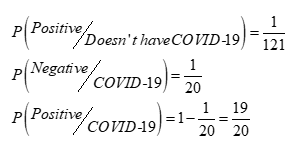Exercise 7. Swab-seq is the testing tool used at UCLA to identify COVID-19 cases. According to a paper published in Scientific Reports, the False positive rate for Swab-seq (the probability that 2 someone who doesn't have COVID-19, tests positive) is 1/121. No false negative rate (probability that someone who has COVID-19, tests negative), was given in that paper, but current estimates from the UK for PCR-based testing are that it is around 1/20. (a) The current incidence of COVID in Los Angeles is 91 per 100,000 people. Suppose that someone tests positive for COVID by Swab-Seq. Using Bayes' formula, answer, what is the proba- bility that they actually have COVID? (b) At the peak of the Omicron surge, the incidence of COVID grew to 3000 per 100,000 people. Supposing that someone tested positive for COVID by Swab-Seq during this peak, what was the probability that they actually had COVID? (c) Briefly explain why Bayes' formula gives different answers for the probability that a person has COVID at the two different times.
Exercise 7. Swab-seq is the testing tool used at UCLA to identify COVID-19 cases. According to a paper published in Scientific Reports, the False positive rate for Swab-seq (the probability that 2 someone who doesn't have COVID-19, tests positive) is 1/121. No false negative rate (probability that someone who has COVID-19, tests negative), was given in that paper, but current estimates from the UK for PCR-based testing are that it is around 1/20. (a) The current incidence of COVID in Los Angeles is 91 per 100,000 people. Suppose that someone tests positive for COVID by Swab-Seq. Using Bayes' formula, answer, what is the proba- bility that they actually have COVID? (b) At the peak of the Omicron surge, the incidence of COVID grew to 3000 per 100,000 people. Supposing that someone tested positive for COVID by Swab-Seq during this peak, what was the probability that they actually had COVID? (c) Briefly explain why Bayes' formula gives different answers for the probability that a person has COVID at the two different times.
A First Course in Probability (10th Edition)
10th Edition
ISBN:9780134753119
Author:Sheldon Ross
Publisher:Sheldon Ross
Chapter1: Combinatorial Analysis
Section: Chapter Questions
Problem 1.1P: a. How many different 7-place license plates are possible if the first 2 places are for letters and...
Related questions
Question

Transcribed Image Text:**Exercise 7.** Swab-seq is the testing tool used at UCLA to identify COVID-19 cases. According to a paper published in *Scientific Reports*, the false positive rate for Swab-seq (the probability that someone who doesn’t have COVID-19, tests positive) is 1/121. No false negative rate (probability that someone who has COVID-19, tests negative) was given in that paper, but current estimates from the UK for PCR-based testing are that it is around 1/20.
**(a)** The current incidence of COVID in Los Angeles is 91 per 100,000 people. Suppose that someone tests positive for COVID by Swab-Seq. Using Bayes’ formula, answer: what is the probability that they actually have COVID?
**(b)** At the peak of the Omicron surge, the incidence of COVID grew to 3000 per 100,000 people. Supposing that someone tested positive for COVID by Swab-Seq during this peak, what was the probability that they actually had COVID?
**(c)** Briefly explain why Bayes’ formula gives different answers for the probability that a person has COVID at the two different times.
Expert Solution
Step 1
Solution:
From the given information, the false positive rate for swab-seq is 1/121, No false negative rate is 1/20.
That is,

Step by step
Solved in 4 steps with 5 images

Recommended textbooks for you

A First Course in Probability (10th Edition)
Probability
ISBN:
9780134753119
Author:
Sheldon Ross
Publisher:
PEARSON


A First Course in Probability (10th Edition)
Probability
ISBN:
9780134753119
Author:
Sheldon Ross
Publisher:
PEARSON
